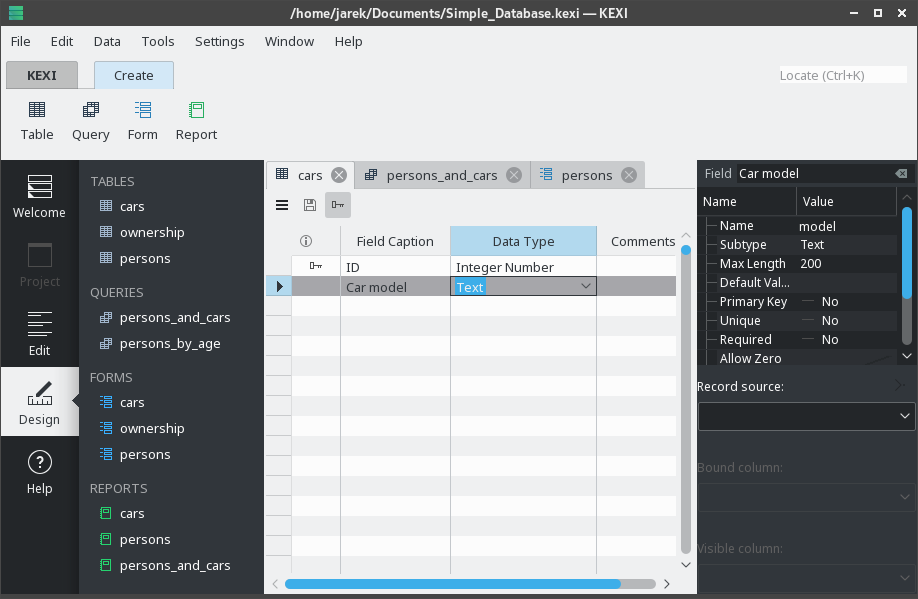Kexi/Handbook/Kexi Basics/The Kexi Main Window/da: Difference between revisions
Importing a new version from external source |
Importing a new version from external source |
||
| Line 7: | Line 7: | ||
'''Værktøjslinjen med faneblade''' for oven giver adgang til almindelige handlinger og kommandoer. | '''Værktøjslinjen med faneblade''' for oven giver adgang til almindelige handlinger og kommandoer. | ||
'''Projektnavigatoren''' og '''Egenskabseditoren''' vises i felter på hver side af undervinduet. Drres størrelse kan ændres efter behov. Et felt kan skjules ved at klikke på det lille kryds øverst i feltet (lige under værktøjslinjen). | |||
Database objects (tables, queries, etc.) listed in the '''Project Navigator''' can be opened by clicking (or double-clicking, depending upon your global KDE settings) on their names. | Database objects (tables, queries, etc.) listed in the '''Project Navigator''' can be opened by clicking (or double-clicking, depending upon your global KDE settings) on their names. | ||
Revision as of 17:06, 17 March 2012
Kexis hovedvindue

Værktøjslinjen med faneblade for oven giver adgang til almindelige handlinger og kommandoer.
Projektnavigatoren og Egenskabseditoren vises i felter på hver side af undervinduet. Drres størrelse kan ændres efter behov. Et felt kan skjules ved at klikke på det lille kryds øverst i feltet (lige under værktøjslinjen).
Database objects (tables, queries, etc.) listed in the Project Navigator can be opened by clicking (or double-clicking, depending upon your global KDE settings) on their names.
Main application elements
Main elements of Kexi application's window are:
- Tabbed Toolbar
- Contains available commands for the application. You will find detailed description of any of the commands in the appendix.
- Project Navigator pane
- Contains a list of any object (tables, queries, forms, ...) created within the currently opened database project. The navigator also contains small toolbar with most usable commands related to the database objects.
- Opened Database Objects Area / Tabbed Windows
- A central area of the application taking most of the screen space. For IDEAl user interface mode it contains switchable tabs with windows that are always maximized. For Childframe user interface mode it contains floating windows.
- Property Editor pane
- Contains a list of properties of currently activated database object. For certain objects (e.g. form's widgets) it can have several tabs.
Tabbed Toolbar
The toolbar is the place that gives you access to most Kexi commands and actions. Using the the actions found in the different tabs on the toolbar you can:
- Create / Open / Close Kexi projects
- Create Database objects
- Import / Export Data
- Create widgets on your Forms
- Create widgets on your Reports
The Project Navigator pane is one of the most frequently used elements of the Kexi main window. The pane contains a list of all objects created within the currently opened Kexi database project. The objects are split into groups: tables, queries, forms, reports and scripts.
The Project Navigator pane also contains a small toolbar for most frequently used commands (from left to right): selected object, selected object, and selected object.
For each object on the list a context menu is available using the right mouse button.
Double clicking with the left mouse button on the object's name on the list opens the object in Data View. If the object's window was already opened, the action just activates the window without switching it's view mode.
Opened database objects area / Tabbed Windows
Whenever you double click an object in the project navigator, it opens in the Opened database objects area. Each window has its own tab in Kexi.
You can rearrange the tabs by drag and drop and close them using the close tab button located at the far right of the tab strip.
Property Editor pane
In the Property Editor pane you can change properties of the object displayed in the active window. Depending on the context, the pane is consisted of one or more tabs. The first, always visible tab, , contains the list of available properties.
Rules for using the Property Editor:
- Each row contains a single property.
- You can use the mouse or the keyboard to change values of particular properties.
- Most frequently used types of property values are:
- a number; you can enter the value directly or increase or decrease its value by clicking with the left mouse button on the arrows.
- text
- drop down list of values
- Yes/No; you can toggle the value by clicking on the button; Yes (true) means that the button is toggled on, No (false) means that the button is toggled off.
The Property Editor pane is empty if:
- no single database object's window is opened, or
- the active database object's window does not offer properties; it is usually the case when it is opened in Data View instead of Design View.

